Tag archives: CERN
The toll of a year in space, running a marathon on the ISS, skip-diving at CERN and more
By Tushna Commissariat and Michael Banks
“A year here is a really really long time,” says astronaut Scott Kelly in an interview (watch the video above) that he did on board the International Space Station (ISS) just a month before he returned to Earth in March this year. The retired astronaut is talking about the very real effects of spending a long period in space, specifically citing both the physical effects as well as the “psychological stress” involved. “During my time in orbit, I lost bone mass, my muscles atrophied and my blood redistributed itself in my body, which strained my heart. Every day I was exposed to 10 times the radiation of a person on Earth, which will increase my risk of developing a fatal cancer for the rest of my life. Not to mention the psychological stress, which is harder to quantify and is perhaps as damaging,” he says.
The comments were part of the announcement of his upcoming memoir, Endurance: My Year in Space and Our Journey to Mars, which will be published later this year. Despite the damming tone, Kelly is still a staunch supporter of manned spaceflight and missions such as those to Mars, he just has a much clearer view on the realities involved. Read more about his announcement over at the GeekWire website.
View all posts by this author | View this author's profile
Thwarting an alien invasion, pi in the sky, listening to the LHC and more
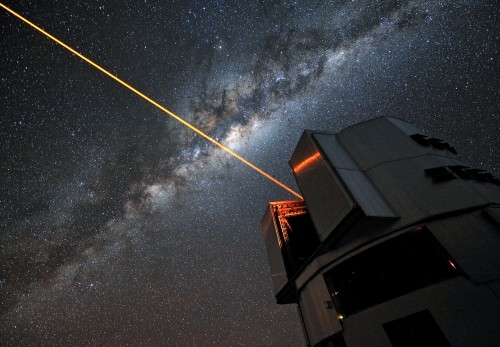
Not bright enough: this adaptive-optics laser would have to be a million times brighter to cloak the Earth. (Courtesy: ESO/G Hüdepohl)
By Hamish Johnston
Sometimes, the biggest laughs on April Fools’ Day come from the stories that read like hoaxes but are actually true. One such item is a proposal by David Kipping and Alex Teachy of Columbia University in the US, who have come up with a way of hiding the Earth from aggressive civilizations on distant planets (at least I think this is real, but I wouldn’t be surprised if it were an elaborate hoax!).
View all posts by this author | View this author's profile
Carried away by a well lit shadow
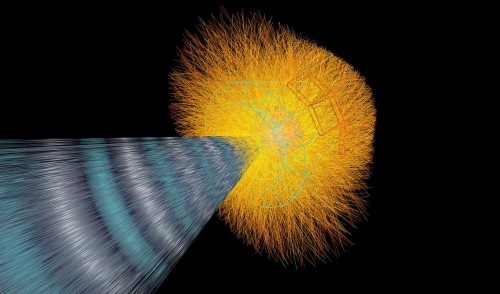
Simulation of a lead-ion collision in the ALICE detector. (Courtesy: CERN)
By James Dacey
As concept albums go, the latest release by Jake Hertzog can certainly be stacked at the intellectual end of your record collection. This week, the US jazz-rock guitarist released his sixth studio album, entitled Well Lit Shadow – a suite of solo electric-guitar tracks inspired by images from the Large Hadron Collider (LHC) and other experiments at the CERN particle-physics lab. You can find details of how to purchase or stream the album on Hertzog’s website.
Now, I’m not the world’s biggest jazz aficionado but I gave the album a listen and it’s far more accessible than the concept might suggest. Hertzog’s musicianship shines through and bright walking riffs on tracks such as “Star Drops” and “Traces of You” evoke images of devoted researchers working through vast amounts of data in pursuit of knowledge. According to Hertzog’s website, some of the pieces are very literal attempts to depict the chaos and beauty of subatomic-particle collisions, while other tracks are more abstract meditations on the deeper meaning of these experiments. The album’s title track is described as “a musical poem dedicated to the philosophical implications of this science”.
View all posts by this author | View this author's profile
CMS on canvas
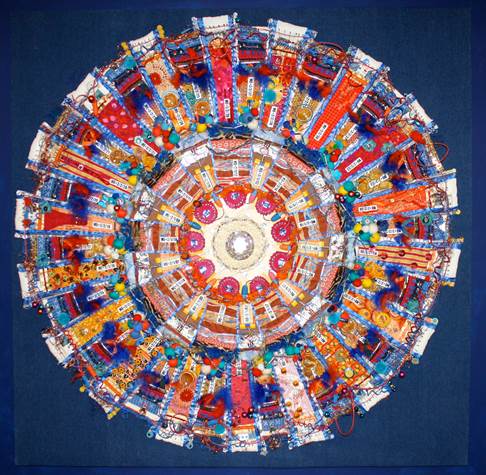
Collage of the CMS detector at CERN created by Genevieve Lovegrove.
By Michael Banks
We’ve already had a LEGO model of the giant CMS detector at CERN’s Large Hadron Collider (LHC) but now University of Leicester modern literature student Genevieve Lovegrove has attempted to go one better by creating a collage of the LHC detector made from everyday objects.
View all posts by this author | View this author's profile
Dismaland physics, laboratory photowalks and more
By James Dacey and Tushna Commissariat
While it may seem as if we Physics World journalists spend our evenings leafing through Newton’s Principia Mathematica or deriving the Dirac equation from first principles, on Wednesday night this week, a few of us visited Dismaland – the pop-up “bemusement park” curated by the elusive British street artist Banksy. Located in the seaside town of Weston-super-Mare – a few miles south-west of the Physics World Bristol HQ – Dismaland offers a darker and more politically motivated alternative to Mickey Mouse and his friends. While our visit was not work-related, there were a few unexpected physics references that we couldn’t help but spot. First we stumbled across “The Astronauts’ Caravan”, a humorous take on the flight simulators used by NASA (see video above).
Created in 2011 by artists and engineers Tim Hunkin and Andy Plant, the outwardly unimpressive-looking theme-park ride is a compact version of the Victorian “haunted swing” illusion. We won’t spoil the magic by explaining the mechanics of the ride here, but you can read this blog by Hunkin where he explains exactly how he and Plant built their spinning caravan and if you can’t visit Dismaland, then watch the video to see what it looks like from the inside.
View all posts by this author | View this author's profile
Playing the cosmic piano
By James Dacey
Researchers at CERN are renowned for their musical side-projects. Notable examples include the album released by scientists at the ATLAS detector in 2010, and the “Large hadron rap“, which currently has almost 8 million hits on YouTube. And of course don’t forget the pop-star-turned-physicist Brian Cox who had the UK chart-topping hit “Things can only get better” in the 1990s with his band D:Ream.
Following in this musical tradition, a duo of Mexican researchers has invented a “Cosmic Piano” inspired by the technologies used at the ALICE particle detector at the Large Hadron Collider (LHC). The instrument’s inventors Arturo Fernández Téllez and Guillermo Tejeda Muñoz hold positions at CERN and the University of Puebla in Mexico. They hope the device can demonstrate both the science and the art of the work being carried out at particle-physics facilities.
View all posts by this author | View this author's profile
The landscapes of CERN, 20 years of BECs and the truth about toilet swirl
By Hamish Johnston
Everyone knows that water in a draining sink or toilet swirls in opposite directions on opposite sides of the equator…or does it? For the answer, watch the instructions in the above video and then go to “The truth about toilet swirl”.
Physicists at CERN are a lucky bunch. As well as having the world’s most energetic collider at their disposal, they are also surrounded by the natural beauty of the Alps and the Jura mountains. However, I’ve always felt that the CERN site itself and the flat farmland that overlays the Large Hadron Collider (LHC) are rather dull.
View all posts by this author | View this author's profile
Heavy-metal Higgs, meet the Publons, Stephen Hawking’s galactic tour and more
By Tushna Commissariat and Hamish Johnston
I’m sure that most of you have wondered what the Higgs boson would sound like if it were a heavy-metal song. Now you can turn it up to 11 (TeV that is) courtesy of CERN physicist and guitarist Piotr Traczyk, who has “sonified” data from two plots from the CMS experiment that were presented at the Higgs discovery seminar on 4 July 2012. His heavy-metal ditty is based on gamma–gamma and 4-lepton data from CMS and after you listen to his excellent song in the above video, you can find out more about how it was created by reading this entry by Traczyk on the Cylindrical Onion blog.
View all posts by this author | View this author's profile
What can cosmic rays tell us about dark matter?
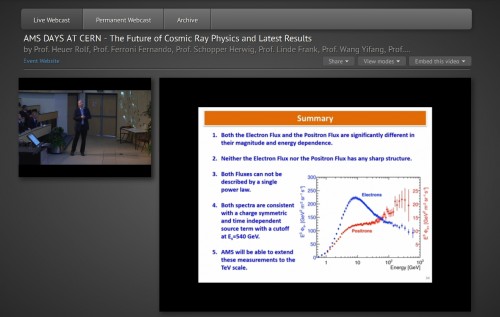
Alive and well: the positron excess as seen by the AMS. (Courtesy: CERN)
By Hamish Johnston
Cosmic rays, dark matter and other astrophysical mysteries are being debated with much vigour at a three-day conference that began this morning at CERN in Geneva. Called “AMS Days at CERN”, the meeting will include presentations of the latest results from the Alpha Magnetic Spectrometer (AMS).
Located on the International Space Station, the AMS measures the energy of high-energy charged particles from the cosmos – otherwise known as cosmic rays. These particles are of great interest because they offer us a window into some of the most violent processes in the universe. Some cosmic rays have probably been accelerated during supernova explosions while others could be produced as matter is sucked into the supermassive black holes that lie at the centres of many galaxies.
View all posts by this author | View this author's profile
Isaac Newton’s Good Friday, art meets physics and our favourite April Fool gags
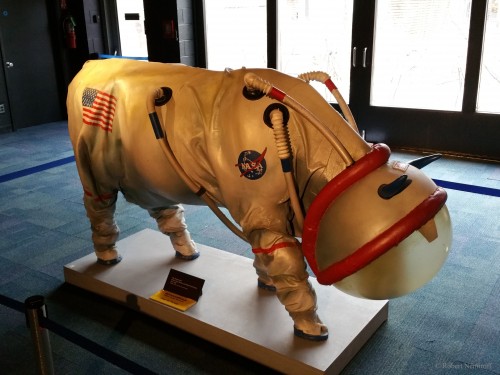
Suiting up for the Moon – an artwork aptly titled “Mooooonwalk”. (Courtesy: APOD/ Robert Nemiroff/Michigan Technological University)
By Hamish Johnston and Tushna Commissariat
As it’s Good Friday today, it can only mean that this week’s Red Folder will include a selection of the best physics-related April Fool jokes from earlier this week. Fermilab’s daily e-bulletin Fermilab Today had an entire joke edition up in the morning – their lead story was probably our favourite as the lab announced its new breakfast cereal dubbed “Neutrin-Os”, but their new day spa sounds pretty good too. CERN went for the funny if slightly obvious Star Wars joke, confirming the existence of the Force, but a slightly more subtle joke came earlier in the week from CERN Bulletin, which ran a story about CERN’s computer-security department handing out prizes for best password – we are still not quite sure if they were joking or not! Astronomy Picture of the Day had a truly fantastic image (see above) of a Lunar Grazing Module described as a “multipurpose celestial bovine containment system”.